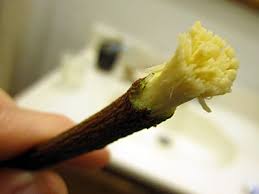

This is a common sight in the villages to get up early in the morning and start plucking some neem branches making a toothbrush out of it and brush their teeth. This was quite common in rural India.Of course, with the advent of many industrially produced fiber toothbrushes, the usage of neem stick for cleaning the teeth has become obsolete and they are unable to stand in competition wth the cheaply produced industrial toothbrushes. People of all ages were experts in making their own toothbrushes.
.

image credit to: blogger’s own image
neem twig vendor on the road of Varanasi
This is a common sight in Varanasi to watch vendors sitting on the road side with packets of twigs. People liberally purchase them for their daily usage.


image credit to: pinterest.com
They were cutting some tender branches from neem tree which has very thin layer and were removing it. They were chewing one end slowly forming a soft bristle. Now it becomes ready to be used as tooth brush. It will be tasting bitter. If it is not possible to bear with the bitter taste, you can pound it and use it again.
Now, after cleaning the teeth you can use the same stick as tongue cleaner by bending it in U-shape or you can opt for another tender branch. If it is not available, remove the bark of the tree take out the thin layer and bend it in U-shape to use it as a tongue cleaner. The other end of the twig can be used as toothpick also.
TWIGS FROM VARIETIES OF TREES
Teeth cleaning twigs can be obtained from many varieties of tree. Although they can be produced from many trees, only those obtained from some trees are effective to be used as teeth cleaning twigs, due to the chemical composition present in them.
The varies species of trees from which these twigs can be prepared are: salvadora persica, Sassafras, Gumtree, Lime tree, Garcinia mannil in Africa, Orange tree, Sheesham in Indian sub-continent, Likquorice, Babool, etc
This usage of twigs of various trees is not confined to India. This was in practice in England, US and other Western countries also. There the twigs were made from the trees like, Apple, pear, Lime, Bamboo, sir birch, liquorice root in the countries like U.K, Europe, and United States. In Australia they are made genrally from Mango tree.
MOST PREFERRED TREE FOR MAKING TWIGS
Though the twigs can be made both from Licorice root and Neem, it is the twigs made from the Need tree that is found to be more effective in cleaning the teeth.
Is it confined to only Hindus IN INDIA?
image credit to: pinterest.com
The answer is that using teeth cleaning twigs was in existence not only in Hindu culture but also many other cultures of the world. In Africa these were made from the Toothbrush Tree, In Islam, they were known as Meshwak, and the Sikhs use Datum even today as written in their scriptures. Thus it is not confined to any particular religion. Their usage was there even among the Buddhists and Jains also and the mention can be found in Tripitaka.
The mention is made in Mahabharata very slightly when Arjuna and Krishna were going to Jarasandha’s Court. The people came out of their houses to see two strangers with sticks in their mouth. It probably refers to the usage of twigs only.
Cleaning the teeth using Tree Twigs is viewed as eco-friendly activity.
How One is benefited?
Nothing can beat these natural tooth brushes in fighting against the Gum diseases and preventing the tooth decay. When the twig is chewed the antibacterial juices flow into the mouth preventing the Gums diseases effectively.
Since mouth Odor is caused by the presence of bacteria present in the mouth, the anti-bacterial liquids fights and kills this bacteria and prevents from mouth odor.
It also works effectively against tooth ache.
The present day tools viz., tooth brushes are quite ineffective when compared to these traditional tree twigs and can not stand for comparison.
People unfortunately, in their eager for modern tools are totally deviating from some of the traditional ways which are quite useful from the health point of view. Now this is the time to them off….let us go traditional
Nggak Nyangka! Hidup Gue Berubah Total! Gue bukan siapa-siapa. Cuma anak kos biasa yang kerja serabutan buat nutup biaya hidup… Read More
What is the Main Cause of a Heart Attack? What is its Solution? A heart attack is the blockage of… Read More
In the vast economic arena, one term that often takes center stage, inciting extensive debates and discussions, is the "debt… Read More
De-Dollarization: The Changing Face of Global Finance The financial landscape is in a state of flux, with an intriguing economic… Read More
The curtains closed on a dramatic Bundesliga season with Bayern Munich standing tall once again, clinching their 11th straight title.… Read More
The Unfolding Story of Celine Dion's Health In recent news that has left fans across the globe stunned, iconic singer… Read More
View Comments
Here the traditional ways of brushing one's teeth is by the soft stems of a guava tree as for me I never experienced using them because my parents always buys me a new toothbrush when I need to replace my old ones they never encourage me to use the traditional ways of brushing buy they often tell me tales of their childhood and some practices that is fading away.
Yes, that's what we would also do as children , when go up those guava trees to get some ripe guavas. After eating those guavas, we would bend a small twig of the guava =, open one end and rub our teeth of it.
Our mother taught us to do that and it was also taught in school that long ago they are what are used for brushing the teeth.